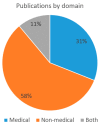Past, Present, and Future of EEG-Based BCI Applications
- PMID: 35591021
- PMCID: PMC9101004
- DOI: 10.3390/s22093331
Past, Present, and Future of EEG-Based BCI Applications
Abstract
An electroencephalography (EEG)-based brain-computer interface (BCI) is a system that provides a pathway between the brain and external devices by interpreting EEG. EEG-based BCI applications have initially been developed for medical purposes, with the aim of facilitating the return of patients to normal life. In addition to the initial aim, EEG-based BCI applications have also gained increasing significance in the non-medical domain, improving the life of healthy people, for instance, by making it more efficient, collaborative and helping develop themselves. The objective of this review is to give a systematic overview of the literature on EEG-based BCI applications from the period of 2009 until 2019. The systematic literature review has been prepared based on three databases PubMed, Web of Science and Scopus. This review was conducted following the PRISMA model. In this review, 202 publications were selected based on specific eligibility criteria. The distribution of the research between the medical and non-medical domain has been analyzed and further categorized into fields of research within the reviewed domains. In this review, the equipment used for gathering EEG data and signal processing methods have also been reviewed. Additionally, current challenges in the field and possibilities for the future have been analyzed.
Keywords: brain–computer interface (BCI); electroencephalography (EEG); rehabilitation; systematic literature review.
Conflict of interest statement
The authors declare no conflict of interest. The funders had no role in the design of the review; in the collection, analyses, or interpretation of data; in the writing of the manuscript; or in the decision to publish the results.
Figures













References
-
- Ramakuri S.K., Peddi A., Rao K.S.N., Gupta B., Ghosh S. First International Conference on Artificial Intelligence and Cognitive Computing. Springer; Singapore: 2019. Performance and Analysis of Human Attention Using Single-Channel Wireless EEG Sensor for Medical Application’; pp. 355–362. - DOI
-
- Anwar D., Gupta A., Naik V., Sharma S.K. Detecting meditation using a dry mono-electrode EEG sensor; Proceedings of the 2017 9th International Conference on Communication Systems and Networks (COMSNETS); Bengaluru, India. 4–8 January 2017; pp. 508–513. - DOI
-
- Al-Nafjan A., Hosny M., Al-Ohali Y., Al-Wabil A. Review and Classification of Emotion Recognition Based on EEG Brain-Computer Interface System Research: A Systematic Review. Appl. Sci. 2017;7:1239. doi: 10.3390/app7121239. - DOI
Publication types
MeSH terms
LinkOut - more resources
Full Text Sources
Other Literature Sources
Miscellaneous

